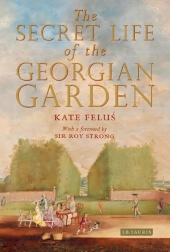The secret life of the Georgian garden
The Secret Life of the Georgian Garden: beautiful objects and agreeable retreats, by Kate Felus, IB Tauris, 2016, 258 pages, 71 black and white illustrations, hardback, ISBN 978 I 784535 72 8.
Here is a book with the author’s personal stamp clearly on it. Writing in the first person singular, Kate Felus starts by describing how she lived and worked at Stowe, Bucks, at the time of the National Trust’s ‘epic restoration’ of the vast garden and its buildings, which began in 1989. From here she undertook a doctoral thesis (the basis of this publication) and now fully devotes her work to consultancy on gardens.
The secrets divulged here are sometimes risqué but mainly present for our consideration the serious reasons why Georgian gardens in the surroundings of the houses of the gentry and nobility contained so many buildings: follies, grottos, eye catchers, temples and so on, and their supplements such as walled plots and glasshouses. We have all seen these, whether dilapidated or thriving, but rarely give much thought to their original purpose. Surprisingly, The Secret Life breaks much new ground, both in its abundant sources, in the interpretation of the fabric that survives, and in the supporting documents. These cover lost buildings as well as those we may still behold.
Such buildings mainly addressed two big problems: the British climate and the crowded nature of domestic life in the houses where family and servants shared limited space. Escaping into the open spaces of the gardens and even into the farthest reaches of great parks, a sudden shower called for the welcome shelter of hospitable buildings.
Planned tours of gardens were laid on for guests. These could take the form of carriage drives round the estate. Such trips might pause for refreshment and entertainment. All of this is explained in the book, with ample evidence that reaches as far as suggesting what might have been on the menu for the outdoor meals. Where lakes were available, the entertainments could include fishing, boating or even the staging of mock sea-battles.
The Secret Life has much to offer. Its contents offer fresh insights into the significance of garden buildings for professionals as well as for a wider reading public. Both will enjoy its entertaining, lucid and thorough approach to a subject that has waited long for a specialist single-volume publication.
This article originally appeared in IHBC's Context 148, March 2017. It was written by Graham Tite, a conservation officer working on buildings and their parkland settings in Buckinghamshire.
--Institute of Historic Building Conservation
[edit] Related articles on Designing Buildings
- Capability Brown.
- Exedra.
- Folly.
- Garden.
- Garden bridge.
- Gardens Trust.
- Georgian.
- Georgian Group Journal.
- Hardy Plants and Plantings for Repton and Late Georgian Gardens (1780-1820).
- IHBC articles.
- Jane Jacobs and garden villages.
- Landscape design.
- Rain garden.
- The Institute of Historic Building Conservation.
- The landscapes of Cambridge.
- Walled kitchen gardens of the Isle of Wight.
- Worcester’s Georgian churches.
IHBC NewsBlog
Old Sarum fire in listed (& disputed) WW1 Hangar - Wiltshire Council has sought legal advice after fire engulfed a listed First World War hangar that was embroiled in a lengthy planning dispute.
UK Antarctic Heritage Trust launches ‘Virtual Visit’ website area
The Trust calls on people to 'Immerse yourself in our heritage – Making Antarctica Accessible'
Southend Council pledge to force Kursaal owners to maintain building
The Council has pledged to use ‘every tool in the toolbox’ if urgent repairs are not carried out.
HE’s Research Magazine publishes a major study of the heritage of England’s suburbs
The article traces the long evolution of an internal programme to research 200 years of suburban growth
IHBC Context 183 Wellbeing and Heritage published
The issue explores issues at the intersection of heritage and wellbeing.
SAVE celebrates 50 years of campaigning 1975-2025
SAVE Britain’s Heritage has announced events across the country to celebrate bringing new life to remarkable buildings.
IHBC Annual School 2025 - Shrewsbury 12-14 June
Themed Heritage in Context – Value: Plan: Change, join in-person or online.
200th Anniversary Celebration of the Modern Railway Planned
The Stockton & Darlington Railway opened on September 27, 1825.
Competence Framework Launched for Sustainability in the Built Environment
The Construction Industry Council (CIC) and the Edge have jointly published the framework.
Historic England Launches Wellbeing Strategy for Heritage
Whether through visiting, volunteering, learning or creative practice, engaging with heritage can strengthen confidence, resilience, hope and social connections.
















Comments
[edit] To make a comment about this article, or to suggest changes, click 'Add a comment' above. Separate your comments from any existing comments by inserting a horizontal line.